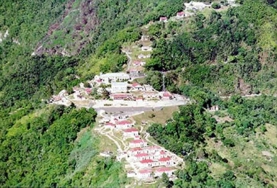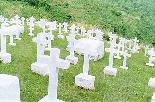|
Camps and Bases
History of Newcastle
In 1991 Newcastle commemorated its 150th year as a military installation. Its story is intertwined with the Jamaican tour of duty of Field Marshal Sir William Gomm. He was, incidentally, Britain’s longest ever serving soldier, having been an ensign at the age of 10 and Constable of the Tower of London over 80 years later at the time of his death in 1875. The idea of establishing a military barracks in the hills of St Andrew was proposed by Gomm, then, as a Major General, Commander of Her Majesty’s forces in Jamaica. In a letter shortly after his arrival in Jamaica, Gomm expressed great concern to the Governor at the high mortality rate among European troops in Kingston. The death rate due to yellow fever in the first half of the 19th century was one soldier every two and a half days; 1838 was a good year with only 91 men dying! In 1839, the number rose again to 110, and to 121 in 1840. This situation, common to the West Indies generally, was so desperate that when the renowned Royal Scots were warned for duty in the West Indies, the officers drew lots as to who would go. It was generally accepted that such a posting was virtually a soldier’s death sentence. Gomm dispatched letter after letter to the British government seeking the authority and finances to start construction of barracks in Newcastle. Initially, these pleas fell on deaf ears as the British government, worried about the expense, persistently ignored the dangerous and cruel loss in manpower resulting from yellow fever.
Today, the visible memorials of that era – and of the relatively small number of soldiers who died there – are two immaculately maintained small cemeteries in Newcastle.
In 1959 the famous old West India Regiment was re-formed and Newcastle became the Federal Defence Force Training Depot, training recruits from all over the newly formed West Indies Federation. In 1962, when the unsuccessful Federation was dissolved, the Regiment was disbanded. Jamaica simultaneously sought her Independence, which was achieved on 6 August 1962. Newcastle was given to the Jamaican Government by Britain as part of a general settlement of all military lands in Jamaica. Following Jamaica’s Independence in 1962, Newcastle became the Jamaica Defence Force (JDF) Training Depot. |
 Eventually, Gomm acted on his own, knowing that he had the
approval of the Governor. Without British Government consent he started construction early
in 1841 at the Newcastle coffee plantation. In December 1841 the Board of Ordnance
authorized erection of a permanent barrack at Newcastle to house a battalion. Gomm had at
last won his battle. In 1842, very soon after Newcastle was established, only 24 of
197 troops died there. Five years later only seven men died from a strength of 583, and in
1853, a mere two men perished out of 476.
Eventually, Gomm acted on his own, knowing that he had the
approval of the Governor. Without British Government consent he started construction early
in 1841 at the Newcastle coffee plantation. In December 1841 the Board of Ordnance
authorized erection of a permanent barrack at Newcastle to house a battalion. Gomm had at
last won his battle. In 1842, very soon after Newcastle was established, only 24 of
197 troops died there. Five years later only seven men died from a strength of 583, and in
1853, a mere two men perished out of 476.  From its founding until 1959, Newcastle was used by
both British and (during World War II) Canadian regiments serving in Jamaica as a
change-of-air camp. Some regiments moved to the hills completely, while others would
rotate companies during the year. Others merely sent cadres for training at
Newcastle.
From its founding until 1959, Newcastle was used by
both British and (during World War II) Canadian regiments serving in Jamaica as a
change-of-air camp. Some regiments moved to the hills completely, while others would
rotate companies during the year. Others merely sent cadres for training at
Newcastle.